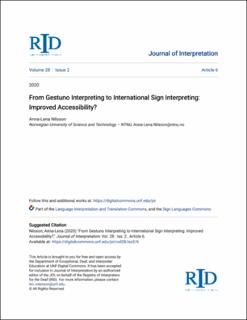| dc.contributor.author | Nilsson, Anna-Lena | |
| dc.date.accessioned | 2021-03-03T11:39:59Z | |
| dc.date.available | 2021-03-03T11:39:59Z | |
| dc.date.created | 2020-11-26T10:53:43Z | |
| dc.date.issued | 2020 | |
| dc.identifier.citation | Journal of Interpretation. 2020, 28 (2), . | en_US |
| dc.identifier.issn | 0882-7893 | |
| dc.identifier.uri | https://hdl.handle.net/11250/2731384 | |
| dc.description.abstract | In order to shape the future of our profession, I believe it is necessary for us to also take a critical look at both past and present practices. With that goal in mind, this commentary presents a case study of the sign language interpreting services provided at the World Federation of the Deaf (WFD) Congresses held between 1983 and 2019. During the 1980s and 1990s we witnessed both the professionalization of signed language interpreting at international conferences, and improved accessibility for official delegates of various National Associations of the Deaf (NADs) as well as for other participants. Increasing numbers of interpreters worked at the congresses. Additionally, measures were gradually taken to provide all working interpreters with adequate preparation materials, quiet rooms to prepare in, meetings with presenters, easy and quick access to food in breaks, etc. Gradually, however, we have seen a decline in the numbers of NAD-interpreters working into/from their national signed languages at WFD congresses. The so called Gestuno-interpreting has been replaced with International Sign-interpreting (IS-interpreting). This has gradually also lead to increased focus on providing specialized IS-interpreters, and also on providing services for them. Ii is now time for us to step back and take a look at the changes we have seen. Are we convinced that the development we have seen is for the best? Will the increasing use of IS-interpreting at a number of international conferences and meetings ensure deaf people around the globe equal accessibility in a broader sense? Will this focus on interpreting into/from something other than national signed language ensure that the linguistic rights of deaf people are being preserved? Is this what is best for the interpreting profession in the long run? | en_US |
| dc.language.iso | eng | en_US |
| dc.publisher | UNF Digital Commons | en_US |
| dc.relation.uri | https://digitalcommons.unf.edu/joi/vol28/iss2/6/ | |
| dc.subject | Tegnspråktolking | en_US |
| dc.subject | Sign Language Interpreting | en_US |
| dc.title | From Gestuno Interpreting to International Sign Interpreting: Improved Accessibility? | en_US |
| dc.type | Peer reviewed | en_US |
| dc.type | Journal article | en_US |
| dc.description.version | publishedVersion | en_US |
| dc.subject.nsi | VDP::Tegnspråk: 013 | en_US |
| dc.subject.nsi | VDP::Sign language: 013 | en_US |
| dc.source.pagenumber | 10 | en_US |
| dc.source.volume | 28 | en_US |
| dc.source.journal | Journal of Interpretation | en_US |
| dc.source.issue | 2 | en_US |
| dc.identifier.cristin | 1852718 | |
| cristin.ispublished | true | |
| cristin.fulltext | postprint | |
| cristin.fulltext | postprint | |
| cristin.qualitycode | 1 | |
